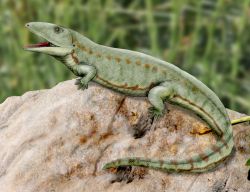Labyrinthodonts
| "Labyrinthodontia"* Fossil range: 395–120.5 Ma Descendant taxa Amniotes and Lissamphibians survive to present. |
||||||||||
|---|---|---|---|---|---|---|---|---|---|---|
 Artist's conception of a Proterogyrinus, an anthracosaur.
|
||||||||||
| Scientific classification | ||||||||||
|
||||||||||
| Included groups | ||||||||||
|
||||||||||
| Excluded groups | ||||||||||
|
Labyrinthodontia (Greek, "maze-toothed") is an extinct amphibian subclass, which constituted some of the dominant animals of late Paleozoic and early Mesozoic eras (about 390 to 150 million years ago). The group evolved from lobe-finned fishes in the Devonian and is ancestral to all extant landliving vertebrates. As such it constitutes an evolutionary grade (a paraphyletic group) rather than a natural group (clade). The name describes the pattern of infolding of the dentin and enamel of the teeth, which are often the only part of the creatures that fossilize. They are also distinguished by a heavily armoured skull roof (hence the older name "Stegocephalia"), and complex vertebrae, the structure of which is useful in older classifications of the group.
Because labyrinthodonts do not form a monophyletic group, many modern researchers have abandoned the term. However, some have continued to use the group in their classifications, at least informally, pending more detailed study of their relationships.
The labyrinthodonts flourished for more than 200 million years. Particularly the early forms exhibited a lot of variation, yet there are still a few basic anatomical traits that make their fossils very distinct and easily recognisable in the field:
Labyrinthodonts were generally amphibian-like in build. They were short-legged and mostly large headed, with moderately short to long tails. Many groups, and all the early forms, were large animals. Primitive members of all labyrinthodont groups were probably true water predators, and various degrees of amphibious, semi-aquatic and semi terrestrial modes of living arose independently in different groups. Some lineages remained waterbound or became secondarily fully aquatic with reduced limbs and elongated, eel-like bodies.
...
Wikipedia
